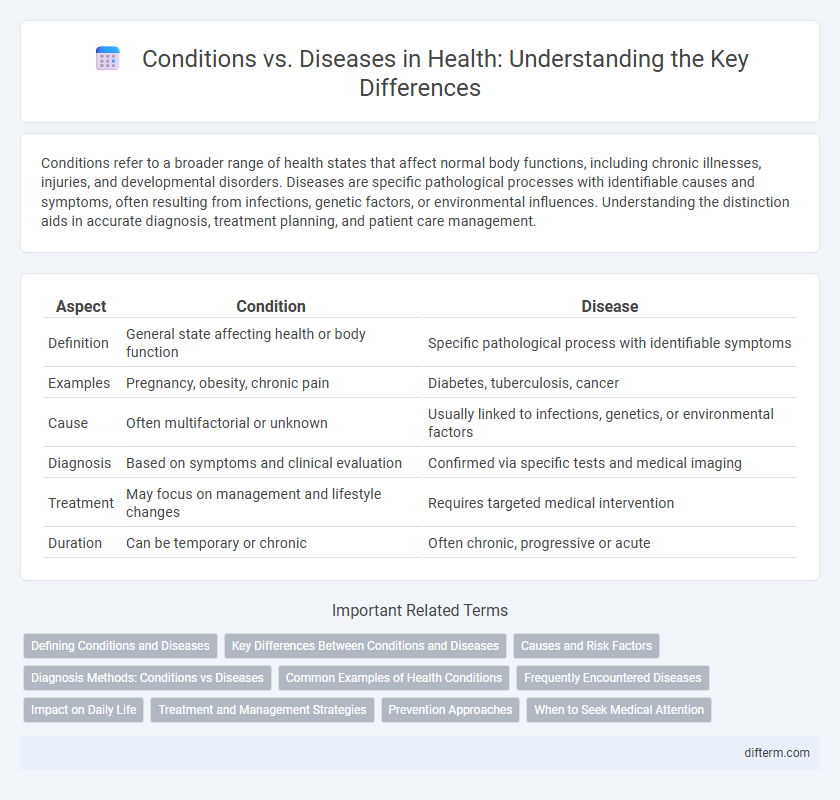Conditions refer to a broader range of health states that affect normal body functions, including chronic illnesses, injuries, and developmental disorders. Diseases are specific pathological processes with identifiable causes and symptoms, often resulting from infections, genetic factors, or environmental influences. Understanding the distinction aids in accurate diagnosis, treatment planning, and patient care management.
Table of Comparison
| Aspect | Condition | Disease |
|---|---|---|
| Definition | General state affecting health or body function | Specific pathological process with identifiable symptoms |
| Examples | Pregnancy, obesity, chronic pain | Diabetes, tuberculosis, cancer |
| Cause | Often multifactorial or unknown | Usually linked to infections, genetics, or environmental factors |
| Diagnosis | Based on symptoms and clinical evaluation | Confirmed via specific tests and medical imaging |
| Treatment | May focus on management and lifestyle changes | Requires targeted medical intervention |
| Duration | Can be temporary or chronic | Often chronic, progressive or acute |
Defining Conditions and Diseases
Conditions refer to health states that vary in severity and duration, encompassing chronic issues like asthma or temporary ailments such as dehydration. Diseases are specific pathological processes characterized by identifiable signs and symptoms, often caused by infections, genetic factors, or environmental influences. Understanding the distinctions helps in diagnosis, treatment planning, and patient education within medical practice.
Key Differences Between Conditions and Diseases
Conditions refer to any state of health that deviates from normal but may not have a defined cause, while diseases are characterized by specific pathological processes and symptoms. Conditions can be transient or chronic and often encompass a broad range of health issues, including injuries and disabilities. Diseases typically require precise diagnosis and targeted treatment due to their identifiable etiology and clinical manifestations.
Causes and Risk Factors
Conditions and diseases differ primarily in complexity and origin, where conditions often refer to health states with multiple causes while diseases typically result from specific pathological processes. Causes of diseases include infections, genetic mutations, and environmental exposures, whereas conditions may stem from lifestyle factors, hormonal imbalances, or chronic stress. Risk factors such as age, family history, diet, and exposure to toxins increase susceptibility to both conditions and diseases, highlighting the importance of early detection and preventive care.
Diagnosis Methods: Conditions vs Diseases
Diagnosis methods for conditions often rely on symptom assessment and patient history analysis, while diseases typically require more specific tests such as blood work, imaging, or biopsies to confirm. Conditions like allergies or chronic pain may be identified through clinical evaluation, whereas diseases such as diabetes or cancer involve laboratory diagnostics and advanced screening techniques. Accurate diagnosis depends on the interplay between clinical observation and targeted diagnostic tools tailored to either condition or disease classification.
Common Examples of Health Conditions
Common health conditions include hypertension, asthma, diabetes, and arthritis, which affect millions globally and require ongoing management. Unlike diseases, conditions like obesity or anxiety disorders may not have a clear pathological cause but significantly impact quality of life. Understanding these examples helps differentiate between chronic diseases and varying health conditions for better treatment strategies.
Frequently Encountered Diseases
Frequently encountered diseases such as diabetes, hypertension, and influenza are classified by specific diagnostic criteria and measurable symptoms, distinguishing them from broader health conditions that may include temporary or less-defined states. These diseases often require targeted medical interventions and continuous management to prevent complications and improve patient outcomes. Understanding the distinctions between chronic diseases and acute conditions is essential for effective public health strategies and personalized treatment plans.
Impact on Daily Life
Conditions and diseases both affect health, but their impact on daily life varies significantly. Chronic conditions like arthritis may cause persistent discomfort and limit mobility, requiring ongoing management and lifestyle adjustments. Diseases such as influenza often lead to temporary incapacitation, disrupting routines but usually resolving with treatment.
Treatment and Management Strategies
Effective treatment of conditions often involves symptom management and lifestyle modifications, while diseases typically require targeted medical interventions such as pharmacotherapy, surgery, or specialized therapies. Chronic conditions may benefit from ongoing monitoring and patient education to prevent progression, whereas acute diseases demand immediate and intensive treatment to resolve the underlying cause. Integrated care approaches combining medication, physical therapy, and psychological support enhance outcomes in both conditions and diseases.
Prevention Approaches
Conditions and diseases differ in definition, where conditions may include chronic states like hypertension, while diseases refer to specific pathological processes such as diabetes. Prevention approaches emphasize lifestyle modifications, including balanced nutrition, regular physical activity, and stress management, to mitigate risk factors before symptoms or diagnoses develop. Early screening and public health education remain crucial strategies in reducing the incidence and severity of both conditions and diseases.
When to Seek Medical Attention
Seek medical attention promptly when symptoms worsen, persist beyond a reasonable timeframe, or interfere with daily activities, regardless of whether the issue is a condition or disease. Conditions such as chronic migraines or hypertension require monitoring to prevent complications, while diseases like infections or autoimmune disorders often necessitate immediate intervention to avoid progression. Timely consultation with healthcare providers ensures accurate diagnosis, effective treatment, and improved health outcomes.
Conditions vs diseases Infographic

 difterm.com
difterm.com